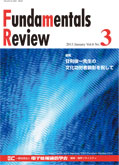Volume 6, Issue 3
Displaying 1-19 of 19 articles from this issue
- |<
- <
- 1
- >
- >|
Cover
-
2013 Volume 6 Issue 3 Pages 6_0
Published: January 01, 2013
Released on J-STAGE: January 01, 2013
Download PDF (250K) -
2013 Volume 6 Issue 3 Pages 159
Published: January 01, 2013
Released on J-STAGE: January 01, 2013
Download PDF (336K)
Preface
-
2013 Volume 6 Issue 3 Pages 160-163
Published: January 01, 2013
Released on J-STAGE: January 01, 2013
Download PDF (1223K)
Congratulatory Message
-
2013 Volume 6 Issue 3 Pages 164-165
Published: January 01, 2013
Released on J-STAGE: January 01, 2013
Download PDF (500K)
Review Papers
Proposed by US
-
2013 Volume 6 Issue 3 Pages 166-174
Published: January 01, 2013
Released on J-STAGE: January 01, 2013
Download PDF (2484K)
Proposed by IT
-
2013 Volume 6 Issue 3 Pages 175-198
Published: January 01, 2013
Released on J-STAGE: January 01, 2013
Download PDF (1721K)
Proposed by SITE
-
2013 Volume 6 Issue 3 Pages 199-209
Published: January 01, 2013
Released on J-STAGE: January 01, 2013
Download PDF (2054K)
Proposed by VLD
-
2013 Volume 6 Issue 3 Pages 210-217
Published: January 01, 2013
Released on J-STAGE: January 01, 2013
Download PDF (3640K)
Miscellaneous Articles
ESS News
-
2013 Volume 6 Issue 3 Pages 218
Published: January 01, 2013
Released on J-STAGE: January 01, 2013
Download PDF (367K)
International Conference Report
-
2013 Volume 6 Issue 3 Pages 219-222
Published: January 01, 2013
Released on J-STAGE: January 01, 2013
Download PDF (2088K) -
2013 Volume 6 Issue 3 Pages 223-224
Published: January 01, 2013
Released on J-STAGE: January 01, 2013
Download PDF (729K)
Let's go to IEICE Workshops!
-
2013 Volume 6 Issue 3 Pages 225-226
Published: January 01, 2013
Released on J-STAGE: January 01, 2013
Download PDF (426K) -
2013 Volume 6 Issue 3 Pages 226-227
Published: January 01, 2013
Released on J-STAGE: January 01, 2013
Download PDF (358K) -
2013 Volume 6 Issue 3 Pages 227-228
Published: January 01, 2013
Released on J-STAGE: January 01, 2013
Download PDF (411K)
Winners' Voice
-
2013 Volume 6 Issue 3 Pages 229-234
Published: January 01, 2013
Released on J-STAGE: January 01, 2013
Download PDF (2064K)
Kitasenju Report
-
2013 Volume 6 Issue 3 Pages 235-236
Published: January 01, 2013
Released on J-STAGE: January 01, 2013
Download PDF (930K)
Silicon Valley Report
-
2013 Volume 6 Issue 3 Pages 237-238
Published: January 01, 2013
Released on J-STAGE: January 01, 2013
Download PDF (398K)
Call for Papers
-
2013 Volume 6 Issue 3 Pages 239
Published: January 01, 2013
Released on J-STAGE: January 01, 2013
Download PDF (1092K)
Committees & Editors Notes
-
2013 Volume 6 Issue 3 Pages 240-242
Published: January 01, 2013
Released on J-STAGE: January 01, 2013
Download PDF (460K)
- |<
- <
- 1
- >
- >|
